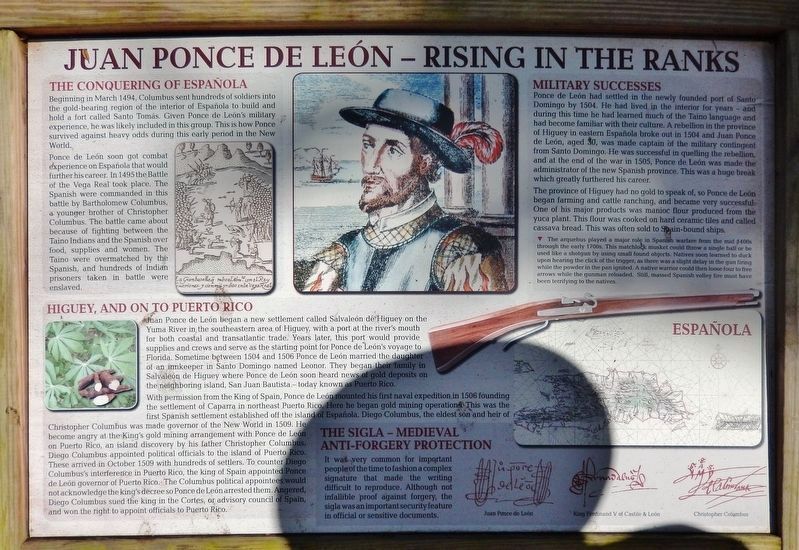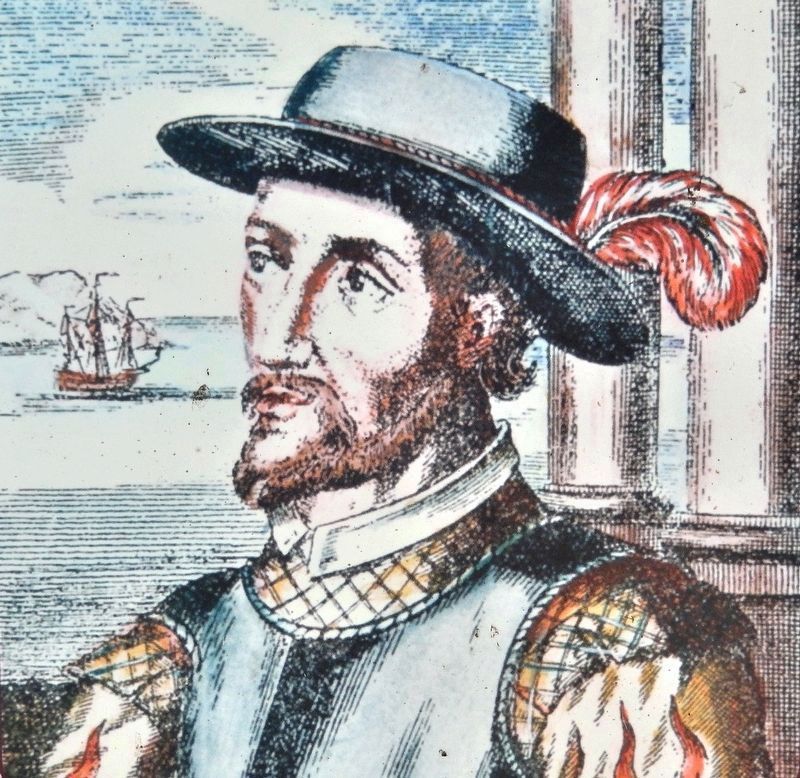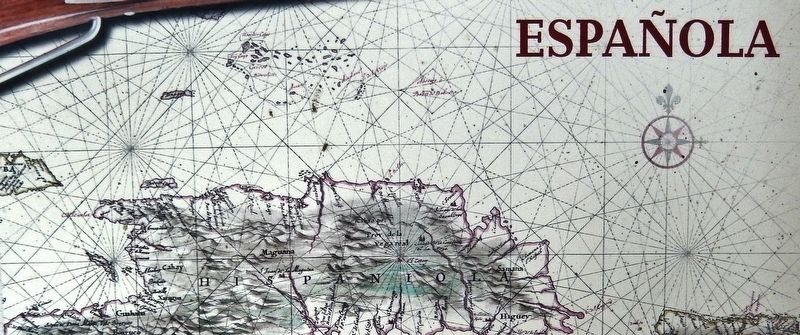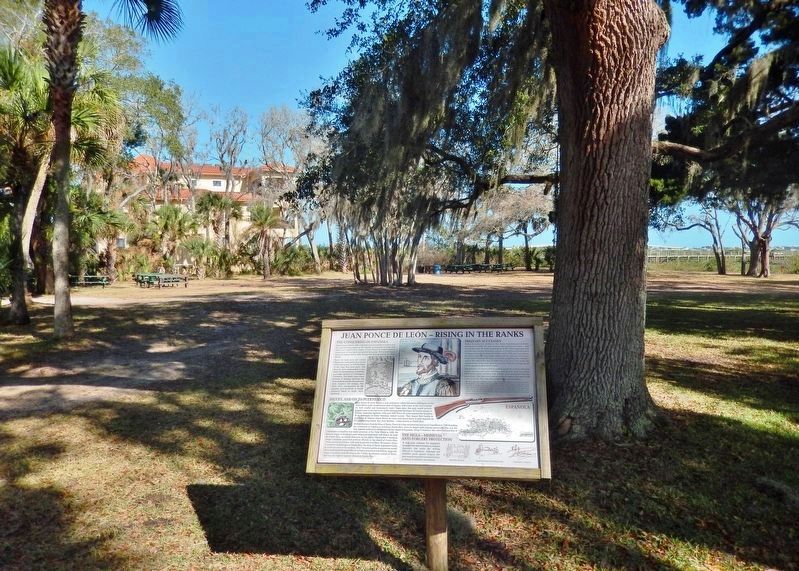Historic District in St. Augustine in St. Johns County, Florida — The American South (South Atlantic)
Juan Ponce De León
Rising in the Ranks
The Conquering of Española
Beginning in March 1494, Columbus sent hundreds of soldiers into the gold-bearing region of the interior of Espanola to build and hold a fort called Santo Tomás. Given Ponce de León’s military experience, he was likely included in this group. This is how Ponce survived against heavy odds during this early period in the New World.
Ponce de León soon got combat experience on Española that would further his career. In 1495 the Battle of the Vega Real took place. The Spanish were commanded in this battle by Bartholomew Columbus, a younger brother of Christopher Columbus. The battle came about because of fighting between the Taino Indians and the Spanish over food, supplies and women. The Taino were overmatched by the Spanish, and hundreds of Indian prisoners taken in battle were enslaved.
Higuey, and on to Puerto Rico
Juan Ponce de León began a new settlement called Salvaleón de Higuey on the Yuma River in the southeastern area of Higuey, with a port at the river's mouth for both coastal and transatlantic trade. Years later, this port would provide supplies and crews and serve as the starting point for Ponce de León's voyage to Florida. Sometime between 1504 and 1506 Ponce de León married the daughter of an innkeeper in Santo Domingo named Leónor. They began their family in Salvaleón de Higuey where Ponce de León soon heard news of gold deposits on the neighboring island, San Juan Bautista — today known as Puerto Rico.
With permission from the King of Spain, Ponce de León mounted his first naval expedition in 1506 founding the settlement of Caparra in northeast Puerto Rico. Here he began gold mining operations. This was the first Spanish settlement established off the island of Española. Diego Columbus, the eldest son and heir of Christopher Columbus was made governor of the New World in 1509. He became angry at the King's gold mining arrangement with Ponce de León on Puerto Rico, an island discovery by his father Christopher Columbus. Diego Columbus appointed political officials to the island of Puerto Rico. These arrived in October 1509 with hundreds of settlers. To counter Diego Columbus's interference in Puerto Rico, the king of Spain appointed Ponce de León governor of Puerto Rico. The Columbus political appointees would not acknowledge the king's decree so Ponce de León arrested them. Angered, Diego Columbus sued the king in the Cortes, or advisory council of Spain, and won the right to appoint officials to Puerto Rico.
Military Successes
Ponce de León had settled in the newly founded port of Santo Domingo by 1504. He had lived in the interior for years — and during this time he had learned much of the Taino language and had become familiar with their culture. A rebellion in the province of Higuey in eastern Española broke out in 1504 and Juan Ponce de León, aged 30, was made captain of the military contingent from Santo Domingo. He was successful in quelling the rebellion, and at the end of the war in 1505, Ponce de León was made the administrator of the new Spanish province. This was a huge break which greatly furthered his career.
The province of Higuey had no gold to speak of, so Ponce de León began farming and cattle ranching, and became very successful. One of his major products was manioc flour produced from the yuca plant. This flour was cooked on hard ceramic tiles and called cassava bread. This was often sold to Spain-bound ships.
The Sigla — Medieval Anti-forgery Protection
It was very common for important people of the time to fashion a complex signature that made the writing difficult to reproduce. Although not infallible proof against forgery, the sigla was an important security feature in official or sensitive documents.
Topics. This historical marker is listed in these topic lists: Colonial Era • Exploration • Settlements & Settlers • Waterways & Vessels. A significant historical month for this entry is March 1494.
Location. 29° 54.425′ N, 81° 18.857′ W. Marker is in St. Augustine, Florida, in St. Johns County. It is in the Historic District. Marker can be reached from Williams Street east of Magnolia Avenue when traveling east. Marker is located along the interpretive trail in Ponce de León's Fountain of Youth Archaeological Park. Touch for map. Marker is at or near this postal address: 11 Magnolia Avenue, Saint Augustine FL 32084, United States of America. Touch for directions.
Other nearby markers. At least 8 other markers are within walking distance of this marker. The Fountain of Youth (here, next to this marker); Juan Ponce De Leon (a few steps from this marker); a different marker also named Juan Ponce De León (a few steps from this marker); a different marker also named Juan Ponce De León (a few steps from this marker); a different marker also named Juan Ponce De León (a few steps from this marker); The Matchlock Arquebus (within shouting distance of this marker); Continuing Archaeology (within shouting distance of this marker); Don Juan Ponce De Leon (within shouting distance of this marker). Touch for a list and map of all markers in St. Augustine.
Related markers. Click here for a list of markers that are related to this marker. Ponce de León's Fountain of Youth Archaeological Park
Also see . . . Juan Ponce de León - The Great Pioneer of Puerto Rico and Florida.
At the time that Juan Ponce populated a town called Higüey, he made and built a house of stone and upholstery and limescale at his expense, which was made for the town's fortress, in which he maintained his hamlet and abode. The house still stands today, converted into Casa Museo de Ponce de León (House Museum of Ponce de León), in San Rafael del Yuma, a municipality of the province of Altagracia forty minutes drive from the beaches of Punta Cana.(Submitted on December 21, 2021, by Cosmos Mariner of Cape Canaveral, Florida.)

5. Marker detail: Arquebus
The arquebus played a major role in Spanish warfare from the mid 1400s through the early 1700s. This matchlock musket could throw a single ball or be used like a shotgun by using small found objects. Natives soon learned to duck upon hearing the click of the trigger, as there was a slight delay in the gun firing while the powder in the pan ignited. A native warrior could then loose four to five arrows while the gunman reloaded. Still, massed Spanish volley fire must have been terrifying to the natives.
Credits. This page was last revised on December 29, 2021. It was originally submitted on December 20, 2021, by Cosmos Mariner of Cape Canaveral, Florida. This page has been viewed 473 times since then and 57 times this year. Photos: 1, 2, 3, 4, 5, 6. submitted on December 21, 2021, by Cosmos Mariner of Cape Canaveral, Florida.




